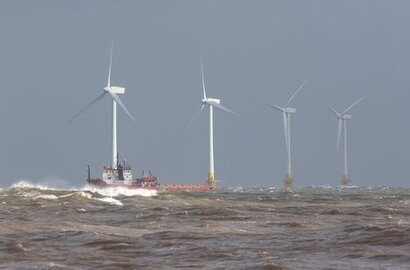
The increase in Vestdavit’s orderbook was fuelled by growth in both its core market segments - global navies and coast guards, and offshore energy. In addition, after-sales revenue from spare parts and service rose by an impressive 30 percent. He is also bullish about market prospects for the coming year and predicts sales growth in 2023 could even exceed the annual average of 20 percent over the past five years.
This optimism is fuelled by an expected boom in offshore wind farm developments - mainly in the US and Europe - that require service operation vessels (SOVs) with safe and efficient davit systems with a wide operational window for service and maintenance of wind turbines.
“We are very pleased with this development as we saw both increased sales to existing customers and we formed new business relationships” said Vestdavit managing director Rolf Andreas Wigand. “The whole wind industry and its value chain is expanding rapidly. We see a strong growth in the offshore wind sector with several newbuilds tailored for this sector contracted by shipowners. The SOV operators are looking for reliable and durable davits, which is right up our alley.”
In particular, he points to Vestdavit’s offering of both single and dual-point davits for service boats and other daughter craft with heavy-duty handling capacity of between 12 and 30 tonnes, in line with the weightier workboats needed to transport service crews for work on wind farms.
Vestdavit contracted seven 12 tonnes+ SWL (Safe Working Load) davits with the SOV market last year, including a prestigious order with Danish shipowner Esvagt for a pair of dual-point davits with 30-tonne SWL capacity, which Wigand says “represents a big leap forward for offshore wind service boats”.
The company's biggest seller last year was the Telescopic Dual Beam (TDB) davit-range that accounted for 40 percent of the overall orders tally, which Wigand believes is an example of the company’s strategy of continuous product development paying dividends.
Originally patented in the 1990s, the TDB has been further developed and refined with improved quality and easier maintenance, and the ceiling-mounted davit is now proving to be an important element in mission bay boat-handling systems being incorporated in new ship designs.
One of these new features has been incorporated in a davit delivery to a US Navy project and Wigand sees further orders coming from the US, which remains Vestdavit’s most important geographical market.
The company won fresh orders from NATO countries and Australia that make up its core markets as many nations invest in naval vessels and patrol ships to protect their borders and offshore resources amid the global geopolitical situation.
Working for the US Navy - the world’s largest - has resulted in Vestdavit’s engineering team being challenged to develop new and improved systems to meet the needs of naval clients, notably with dual-point motion-compensated davits, according to Wigand.
Vestdavit has a range of proven davits and boat-handing solutions for both the naval/coast guard and offshore energy segments that have been developed over several decades but remains on the cutting edge of innovation, driven by the needs of end-users.
The company is currently working on several new initiatives to integrate automation and AI to enable the operator to launch and recover daughter craft more safely, while it is making big efforts in autonomous operation amid an increasing market focus on unmanned vehicles.
For additional information:

